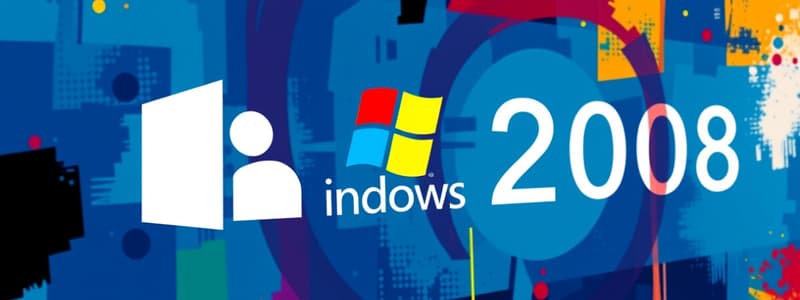Podcast
Questions and Answers
What is necessary for a user to log in using a domain account?
What is necessary for a user to log in using a domain account?
- A domain controller configured in the network (correct)
- Access to a central password manager
- A local user profile on the computer
- A connection to a standalone server
What is a characteristic of a local account in Windows 2008?
What is a characteristic of a local account in Windows 2008?
- Provides access to resources on other computers
- Authenticated through a domain controller
- Stored on the local machine (correct)
- Requires internet connectivity for login
Which factor is determined by a user account in Windows 2008?
Which factor is determined by a user account in Windows 2008?
- The user's last login time
- The privilege level assigned to the user (correct)
- The user's physical location
- The type of hardware used
Which statement about local accounts is true?
Which statement about local accounts is true?
What does a local account primarily control for the user?
What does a local account primarily control for the user?
What is the primary difference between a standard user and a system administrator?
What is the primary difference between a standard user and a system administrator?
Which of the following tasks can a standard user perform?
Which of the following tasks can a standard user perform?
How does User Account Control (UAC) benefit users?
How does User Account Control (UAC) benefit users?
What functionality does the active directory authentication module provide?
What functionality does the active directory authentication module provide?
Which of the following statements about administrator functions is true?
Which of the following statements about administrator functions is true?
Study Notes
User Administration Concepts and Mechanisms
- Most users have read-only access, unable to edit or configure documents; system administrators have full access and control over administrative tasks.
- Key functions of administrators include creating monitor groups, managing users, and changing user preferences.
- The distinction between standard users and administrators is in the level of access to system configurations and core areas.
User Account Control (UAC)
- UAC allows standard users to perform tasks as non-administrators without switching accounts or logging off.
- Accounts in the local Administrators group run most applications with standard user privileges to improve security.
Active Directory Authentication
- Active Directory authentication facilitates user management by allowing the import of users from the domain for access to applications.
User Accounts in Windows 2008
- User accounts are required for network access, determining login times, workgroup/domain locations, and assigned privilege levels.
Types of User Accounts
- Local Accounts:
- Created on a specific machine, authenticating local access only.
- Suitable for individual standalone systems or member servers, with access restricted to the local machine.
- Domain Accounts:
- Managed through a domain controller, providing centralized control and user management across a network.
- Supports roaming profiles, allowing user data to move with them across different machines.
Roaming Profiles
- Roaming profiles ensure user settings and data are available on any networked computer.
- Changes are copied from a cached local version back to the server upon user logout.
- Benefits include consistent access to user settings across devices and simplified backup processes.
Home Folders
- Home folders collect user files in a centralized location, available as a network drive that can be easily backed up.
Automating Administrative Tasks
- Automation enhances efficiency by performing routine tasks independently, reducing the need for human intervention.
- Scripting and scheduling tools can automate diverse tasks such as software installations, file management, and system notifications.
Password Policy Settings
- Password policies can only be changed by network administrators in a domain environment to enhance security.
- Key components of password policy include:
- Enforce Password History: Prevents reuse of recent passwords, configurable to remember a specified number of past passwords.
- Maximum Password Age: Sets limits on how long a password remains valid before requiring a change; default is 42 days.
- Minimum Password Age: Ensures users keep a password for a specified duration before changing it, usually set between three to seven days to prevent immediate reversion to an old password.
Studying That Suits You
Use AI to generate personalized quizzes and flashcards to suit your learning preferences.
Related Documents
Description
Test your knowledge on user administration, access levels, and key concepts like User Account Control and Active Directory authentication. This quiz covers essential functions of administrators and the structure of user accounts in Windows 2008. Perfect for IT professionals looking to refresh their understanding of user management.




